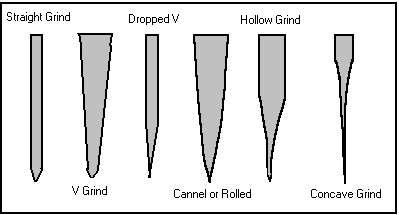
The Blade Bevel

The blade bevel is the ground away portion of the knife
blade that tapers from the back or spine of the knife to its edge. As
previously mentioned, the blade bevel is not the same as the edge bevel,
or cutting edge.
The straight bevel or straight grind is a non bevel. The
edge is honed into a flat blank. This bevel is often found on work-shop
tools and food slicers.
The V grind bevel is a uniform taper that begins at the
back or spine of the knife and tapers to the edge. This edge is common
sporting knives. This grind produces a strong edge that resists chipping
and can be used for chopping. This is the most preferred grind for quality
knives.
The conical, cannel or rolled bevel begins as a V and
curves or rolls to meet the edge. The blade resists chipping and is found
on hot drop forged blade and is finished by hand. This bevel cannot be
duplicated by machine.
The hollow ground bevel has a hollow or dish shaped
concave ground into the leading edge of the blade, below the spine or
back. This grind produces a large area of thin steel near the edge that
facilitates sharpening. This is a grind for knives that can have a
razor sharp edge. This grind is not ideal because it is susceptible
to chipping and the extra force is required to cut through food as you
penetrate deeper.
The concave grind bevel is a little like the hollow
grind except the thickness of the steel does not dish out as it approaches
the edge but rather it meets the edge at an extreme angle. This is the
easiest grind to keep sharp but at the same time produces a weak blade
susceptible to chipping.







 .
.
